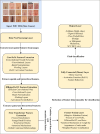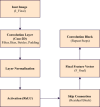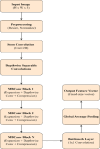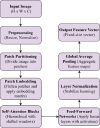SkinEHDLF a hybrid deep learning approach for accurate skin cancer classification in complex systems
- PMID: 40295588
- PMCID: PMC12037884
- DOI: 10.1038/s41598-025-98205-7
SkinEHDLF a hybrid deep learning approach for accurate skin cancer classification in complex systems
Abstract
Skin cancer represents a significant global public health issue, and prompt and precise detection is essential for effective treatment. This study introduces SkinEHDLF, an innovative deep-learning model that enhances skin cancer classification. SkinEHDLF utilizes the advantages of several advanced models, i.e., ConvNeXt, EfficientNetV2, and Swin Transformer, while integrating an adaptive attention-based feature fusion mechanism to enhance the synthesis of acquired features. This hybrid methodology combines ConvNeXt's proficient feature extraction capabilities, EfficientNetV2's scalability, and Swin Transformer's long-range attention mechanisms, resulting in a highly accurate and dependable model. The adaptive attention mechanism dynamically optimizes feature fusion, enabling the model to focus on the most relevant information, enhancing accuracy and reducing false positives. We trained and evaluated SkinEHDLF using the ISIC 2024 dataset, which comprises 401,059 skin lesion images extracted from 3D total-body photography. The dataset is divided into three categories: melanoma, benign lesions, and noncancerous skin anomalies. The findings indicate the superiority of SkinEHDLF compared to current models. In binary skin cancer classification, SkinEHDLF surpassed baseline models, achieving an AUROC of 99.8% and an accuracy of 98.76%. The model attained 98.6% accuracy, 97.9% precision, 97.3% recall, and 99.7% AUROC across all lesion categories in multi-class classification. SkinEHDLF demonstrates a 7.9% enhancement in accuracy and a 28% decrease in false positives, outperforming leading models including ResNet-50, EfficientNet-B3, ViT-B16, and hybrid methodologies such as ResNet-50 + EfficientNet and ViT + CNN, thereby positioning itself as a more precise and reliable solution for automated skin cancer detection. These findings underscore SkinEHDLF's capacity to transform dermatological diagnostics by providing a scalable and accurate method for classifying skin cancer.
Keywords: ConvNeXt; Deep learning; EfficientNetV2; Hybrid model; Skin Cancer detection; Swin transformer.
© 2025. The Author(s).
Conflict of interest statement
Declarations. Competing interests: The authors declare no competing interests. Consent for publication: All authors have reviewed and approved the final manuscript for publication.
Figures














Similar articles
-
A robust deep learning framework for multiclass skin cancer classification.Sci Rep. 2025 Feb 10;15(1):4938. doi: 10.1038/s41598-025-89230-7. Sci Rep. 2025. PMID: 39930026 Free PMC article.
-
Boosting Skin Cancer Classification: A Multi-Scale Attention and Ensemble Approach with Vision Transformers.Sensors (Basel). 2025 Apr 15;25(8):2479. doi: 10.3390/s25082479. Sensors (Basel). 2025. PMID: 40285168 Free PMC article.
-
A comprehensive analysis of deep learning and transfer learning techniques for skin cancer classification.Sci Rep. 2025 Feb 7;15(1):4633. doi: 10.1038/s41598-024-82241-w. Sci Rep. 2025. PMID: 39920179 Free PMC article.
-
Deep Learning Approaches Towards Skin Lesion Segmentation and Classification from Dermoscopic Images - A Review.Curr Med Imaging. 2020;16(5):513-533. doi: 10.2174/1573405615666190129120449. Curr Med Imaging. 2020. PMID: 32484086 Review.
-
Multi-features extraction based on deep learning for skin lesion classification.Tissue Cell. 2022 Feb;74:101701. doi: 10.1016/j.tice.2021.101701. Epub 2021 Nov 25. Tissue Cell. 2022. PMID: 34861582 Review.
References
-
- Mavaddati, S. Skin cancer classification based on a hybrid deep model and long short-term memory. Biomed. Signal Process. Control. 100, 107109 (2025).
-
- Subhashini, G. & Chandrasekar, A. Hybrid deep learning technique for optimal segmentation and classification of multi-class skin cancer. Imaging Sci. J.72 (8), 1043–1064 (2024).
-
- Pacal, I., Ozdemir, B., Zeynalov, J., Gasimov, H. & Pacal, N. A novel CNN-ViT-based deep learning model for early skin cancer diagnosis. Biomed. Signal Process. Control. 104, 107627 (2025).
MeSH terms
LinkOut - more resources
Full Text Sources
Medical

